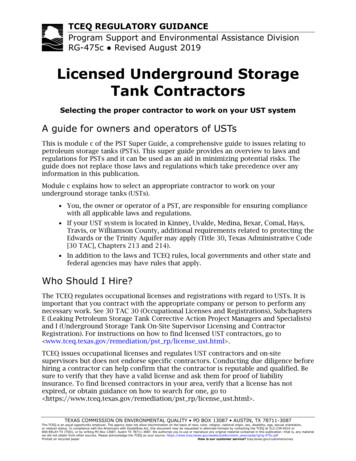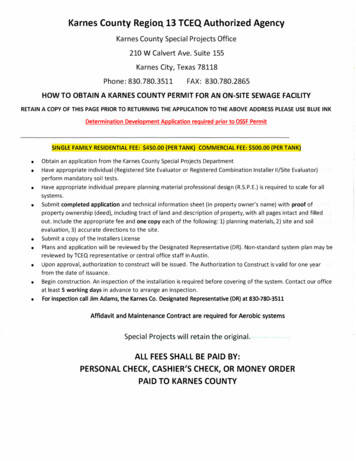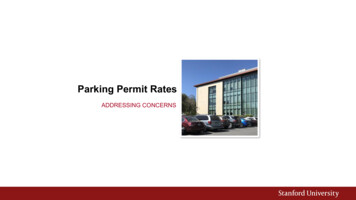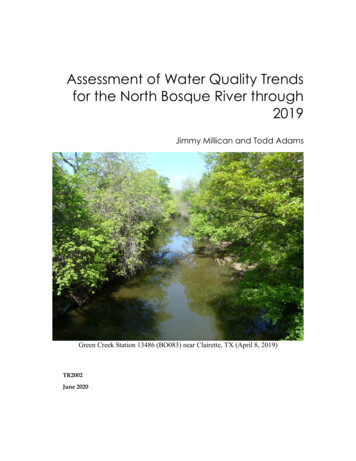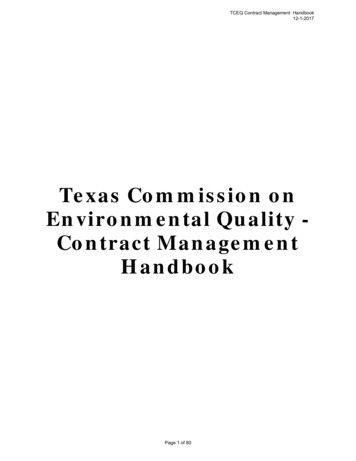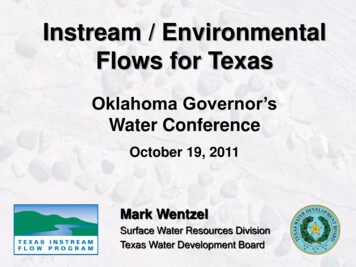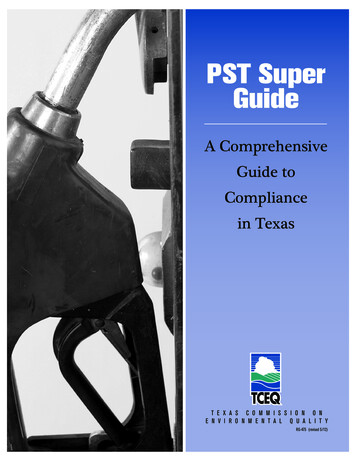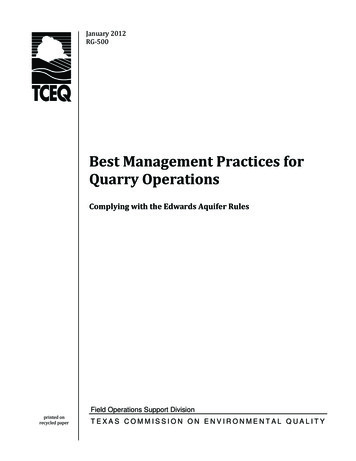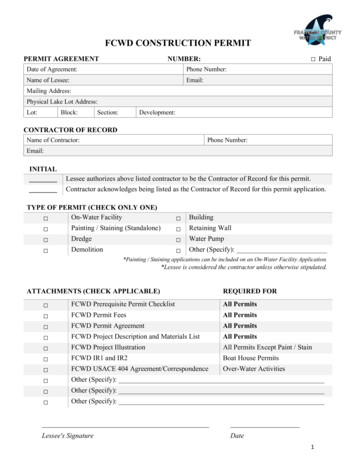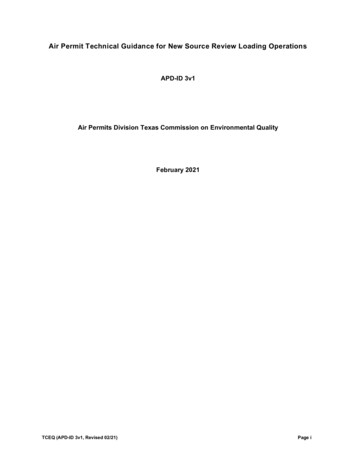
Transcription
Air Permit Technical Guidance for New Source Review Loading OperationsAPD-ID 3v1Air Permits Division Texas Commission on Environmental QualityFebruary 2021TCEQ (APD-ID 3v1, Revised 02/21)Page i
Technical DisclaimerThis Package Is Intended for Instructional Use OnlyThis document is intended as guidance to explain the specific requirements for newsource review permitting of loading operations; it does not supersede or replace anystate or federal law, regulation, or rule. References to abatement equipment technologiesand sample calculations are not intended to represent minimum or maximum levels ofBest Available Control Technology (BACT). Determinations of BACT are made on a caseby-case basis during the review of New Source Review permit applications. BACTdeterminations are always subject to adjustment in consideration of specific processrequirements, air quality concerns, and recent developments in abatement technology.Additionally, specific health effects concerns may result in stricter abatement thanrequired by the BACT determination.The represented calculation methods are intended as an aid in the completion ofacceptable submittals; alternate calculation methods may be equally acceptable if theyare based upon, and adequately demonstrate, sound engineering assumptions or data.These guidelines and any regulations discussed or referenced in this document are applicableas of the publication date of this package but are subject to revision during the applicationpreparation and review period. It is the responsibility of applicants to remain abreast of anyguideline or regulation developments that may affect their industries.The electronic version of this document may not contain attachments/forms/tables thatcan be obtained electronically elsewhere on the Texas Commission on EnvironmentalQuality (TCEQ) website.Examples of boilerplate special conditions are available on the TCEQ Internet site.Special Conditions included in an actual permit are written by the permit reviewer toaddress specific permit requirements and operating conditions.TCEQ (APD-ID 3v1, Revised 02/21)Page 1 of 17
I.OverviewThe purpose of this document is to assist the permit applicant in calculating emissions,planning air abatement methods, identifying applicable State and Federal Regulations,and preparing a permit application for a project to build or modify a loading rack forloading volatile liquids. This document will also be used as a resource by agency staff.Loading operations are conducted at almost every terminal (gasoline and bulk or "forhire" terminals), refinery, petrochemical, and chemical complexes in the state. Thisdocument will describe acceptable methods of calculating emissions from theseoperations and specify acceptable methods of capturing and controlling loading losses.This document does not address emissions from unloading, since these are accountedfor as emissions from the receiving vessel. This document does not comprehensivelyaddress vacuum trucks, although guidance on calculation methods are given.The TCEQ encourages pollution prevention, specifically source reduction, as a means ofeliminating or reducing air emissions from industrial processes. The applicant shouldconsider opportunities to prevent or reduce the generation of emissions at the sourcewhenever possible through methods such as product substitutions, process changes, ortraining. Considering such opportunities prior to designing or applying “end-of-pipe”controls can not only reduce the generation of emissions but may also provide potentialreductions in subsequent control design requirements (e.g., size) and costs.II.Process DescriptionLoading operations may be classified according to the type of vessel being loaded andthe type of facility where a loading operation occurs. The types of vessels loaded can becategorized as tank trucks, railcars, marine vessels (barges and ships), and smallercontainers such as drums or totes. Facilities that conduct loading operations includegasoline terminals, chemical manufacturing facilities, petroleum refineries, for-hirechemical or fuels storage terminals, marine terminals, and small chemical blendingfacilities. Permit requirements depend on both the type of vessel loaded and the type offacility where the loading is conducted.A.Tank TrucksTank trucks are motor vehicles used to transport liquids or gases via roads. Someoperate near atmospheric pressure, while others are rated to handle higherpressures to transport gases or higher vapor pressure liquids. Depending on thetype of fluid transported, tank trucks must be certified to meet specifications fromthe Department of Transportation (DOT). [For example, see 49 Code of FederalRegulations (CFR) §173.33]. Tank trucks are commonly used to transport gasolineand other fuels from terminals to local gasoline stations. Vapor return lines can beattached to route vapors displaced from the loading operation to a control orrecovery device. Different types of connections are used in the loading procedure.“Quick connects” are clamp type connections that are not bolted or flanged. “Quickconnects” can be used with atmospheric trucks, but hard-piped connections thatare bolted or flanged to the receiving vessel should be used with pressure trucks.B.RailcarsSpecially designed railcars are used to transport volatile liquids via trains. Theserailcars are also subject to DOT specifications in 49 CFR §173.31. In most cases,railcars are pressure stressed and use hard-piped and/or bolted connections.Some railcars are equipped with spew gauges for determining the liquid levelinside the railcar.TCEQ (APD-ID 3v1, Revised 02/21)Page 2 of 17
C.Marine VesselsMarine loading can be broken down into two categories: barge and ship. Bargesand ships are used to transport volatile liquids via waterways. Shallow draft bargesgenerally travel only in inland waterways and have compartment depths ofapproximately 10 to 12 feet. Ships travel in international waters and generally havemuch deeper compartments. Ocean-going barges also travel in internationalwaters and have deeper compartments. For emission calculation purposes,ocean-going barges are considered as ships. Ocean-going barges and ships aresubject to regulation by the U.S. Coast Guard and by international maritimeagreements. Very large crude carriers (VLCCs) or ultra large crude carriers(ULCCs) will require a case-by-case review.D.Other ContainersContainers such as drums and totes are used to handle smaller quantities ofchemicals. They are frequently used at smaller chemical blending facilities thatprepare special blends of chemicals. At small facilities, or at facilities handlingmaterials with low vapor pressures, loading may be uncontrolled. For loading oflarger quantities of higher vapor pressure materials, containers can be loadedunder an enclosure so that the displaced vapors can be collected and routed to acontrol or recovery device.E.Types of Loading FacilitiesSome loading operations are conducted directly at the production facility(e.g. petroleum refinery, large chemical manufacturing plant, small chemicalblending installation.) Other loading operations take place at separate facilitiescalled terminals. A terminal consists of storage tanks to store materials prior totransfer and loading racks to transfer the materials into tank trucks, railcars, ormarine vessels. When materials with vapor pressures greater than 0.5 psia orhigher are loaded, a control or recovery device will be used to abate emissionsfrom the loading operations.Terminals may be relatively small, containing only a few tanks and loading limitedmaterials. For example, fuels terminals are used to store gasoline, diesel, ethanol,and special additives that are loaded into tank trucks and delivered toneighborhood gas stations. Other terminals can include hundreds of tanks that areauthorized to store and load a wide range of chemicals, crude petroleum products,or fuels. Some terminals are owned and operated by the same entity that owns thematerials handled. Others, known as “for-hire terminals” rent space in their tanks tooutside entities. In these facilities, the terminal owner/operator does not own thestored material.F.Loading MethodsIn some loading operations, liquids are introduced into the bottom of vessel. Thismethod is called “bottom fill.” Another method is called “submerged fill.” As thename indicates, the submerged fill liquid is introduced through a pipe or hose thatextends below the level of liquid in the vessel being loaded. In “splash loading,”liquid is loaded from the top of the vessel above the liquid level. The splashing thatoccurs as the introduced liquid hits the liquid already present in the vesselcontributes to increased saturation of the vapor space and higher emissions.G.Vacuum trucks are used during maintenance operations for the removal of liquidsfrom storage tanks, other vessels, and equipment, and from spills. Calculation ofTCEQ (APD-ID 3v1, Revised 02/21)Page 3 of 17
emissions and evaluation of controls for vacuum trucks depend upon thecharacteristics of the liquid transferred and on the mode of operation of thevacuum truck. If a positive displacement pump is used to move liquids into thevacuum truck, emissions can be calculated using Equation 1 in Section III. If an airmover is used to transfer liquids into the truck, the results of Equation 1 should bemultiplied by a factor of 2. Some vacuum trucks operate by using a pump to draw avacuum on the vacuum truck tank. The pump is then turned off and liquid is drawninto the tank using the vacuum in the tank. The tank is emptied prior to drawinganother vacuum. In this mode of operation, no emissions would be generatedduring the vacuuming operation.III.Basis for Emission CalculationsA.Basic CalculationEmissions from loading operations are calculated using Equation 1 in AP-42Chapter 5.2 dated June 2008:LL 12.46SPMT(Equation 1)whereL L loading loss, pounds per 1,000 gallons (lbs/1,000 gal) of liquid loadedS saturation factor (dimensionless)P true vapor pressure of liquid loaded, psiaM molecular weight of the vapor in lb/lb-molT temperature of liquid loaded in degrees Rankine ( R F 460).Short-term emissions should be estimated by using the worst-case combination oftemperature and vapor pressure (typically the vapor pressure at the maximumexpected temperature or 95 F, whichever is greater), and the design maximumpumping rate being used to fill the container. Annual emissions should beestimated by using the average annual temperature and vapor pressure of thecompound and the maximum annual throughput of the compound.B.Derivation of Loading Loss EquationLoading losses from filling tank trucks, railcars, marine vessels (ships or barges),or other containers arise when vapors are displaced by the incoming liquid. Thevolume of vapor displaced is equal to the volume of incoming liquid. The ideal gaslaw can be used to estimate the number of moles of pollutant in the displacedvapor:n PV/RT (Equation 2)n number of moles of pollutantP true vapor pressure of liquid loaded (psia)V volume of liquid loaded (gallons)R universal gas constant 80.27 (psia gal)/(lb-mol R)T absolute temperature of liquid loaded ( R).TCEQ (APD-ID 3v1, Revised 02/21)Page 4 of 17
The mass in the vapor is calculated by multiplying the number of moles times themolecular weight.L (M)(n)(Equation 3)L Mass emissions from loading a volume of incoming liquid, VM molecular weight of the vapor in pounds per pound-mole (lb/lb-mol).Mass emissions can be calculated by combining equations 2 and 3:L (P)(V)(M)(R)(T)(Equation 4)Equation 4 can be used to calculate emissions in pounds for loading a volume of1000 gallons of liquid as follows:LL (P psia)(1000 gal)(M)(80.27 psia-gal/lb-mol R)(T)(Equation 5).Simplifying by performing the arithmetic gives equation 6:LL 12.46(P)(M)T(Equation 6).The equations derived above assume that the displaced vapors are fully saturated.The actual saturation is typically less than 100%, but in certain cases it can behigher. AP-42 Chapter 5.2, Equation 1, uses a factor “S” to account for the degreeof saturation. With the addition of the saturation factor, Equation 6 becomes AP-42Chapter 5.2, Equation 1.C.Saturation FactorThe degree of saturation of the displaced vapors depends on the loading method,the geometry of the vessel, and the previous condition of the vessel being loaded.Bottom loading or submerged fill loading generally result in less than 100%saturation. Splash loading can lead to super-saturation (greater than 100%) due tothe carry-over of liquid droplets. Loading of containers that are relatively shallowrelative to their volume (such as tank trucks or barges) leads to higher saturationthan deep containers (such as ships). The degree of saturation also depends onthe previous cargo held by the vessel being loaded, since the initial vaporsdisplaced contain residual vapors from the previous cargo. A vessel that has beencleaned prior to loading will have the lowest saturation, since there are no residualvapors, while a vessel that has been used in vapor balance service will besaturated with vapors from the previous cargo. BACT requires that most loadingoperations be carried out using bottom loading or submerged fill; splash loading isgenerally acceptable only for materials that are so viscous that bottom orsubmerged fill is technically infeasible.TCEQ recommends use of the saturation factors in AP-42 Table 5.2-1 for allloading, including marine loading of gasoline and crude oil. The factors andequations suggested for marine loading of gasoline and crude oil in AP-42 weredeveloped as averages from various tests and do not allow for input of thesite-specific vapor pressure. Although use of these average factors may beappropriate for estimating emissions from a population of sources, calculations forair permitting purposes must be based on a reasonable worst-case estimate ofTCEQ (APD-ID 3v1, Revised 02/21)Page 5 of 17
emissions from a specific source. Therefore, use of the saturation factors forgasoline in AP-42 Chapter 5.2 Table 5.2-2 and equations (2) and (3) for crude oil isnot accepted for permitting purposes.Table 1. Saturation Factors For Calculating Liquid Loading LossesCargo CarrierMode of OperationSaturation Factor(S)Tank trucks and rail tank cars Submerged loading: clean 0.50cargo tankMarine vesselsSubmerged loading:dedicated normal service0.60Submerged loading:dedicated vapor balanceservice1.00Splash loading: cleancargo tank1.45Splash loading: dedicatednormal service1.45Submerged loading: ships 0.2and ocean-going bargesSubmerged loading:shallow draft bargesD.0.5Collection EfficiencyThe procedures discussed above are used to calculate uncontrolled emissionsfrom loading operations. In many cases, emissions must be controlled to satisfyBACT or other regulatory requirements or to reduce impacts from a particularcompound. Because of leaks in the collection system or from the vessel beingloaded, some of the vapors displaced during loading escape capture and areemitted as loading fugitives. (Note that these “loading fugitives” are different thanthe fugitive emissions from equipment leaks described in Technical GuidanceDocument APDG 6422.) Collection efficiencies for the different categories ofcontainers/vessels are discussed below.(1)Tank Truck LoadingCollection efficiency for tank truck loading operations depends on the type oftruck and connections used. If a pressure truck is used in atmospheric orpressure service, 100 percent collection efficiency may be obtained if thepressure truck is leak checked and certified annually in accordance with49 CFR 180.407 DOT standards for pressure rating, and pressure stressedtype connections are used.Atmospheric trucks transporting compounds with a vapor pressure of 0.5 psiaor greater need to be leak checked annually using the procedures in NewSource Performance Standards (NSPS) 40 CFR 60 Subpart XX or MaximumAchievable Control Technology (MACT) 40 CFR 63 Subpart R. Vacuumloading can be used to increase collection efficiency. One hundred percentTCEQ (APD-ID 3v1, Revised 02/21)Page 6 of 17
collection efficiency can be assumed for vacuum loading where a vacuumof -1.5 inches of water is maintained in the truck cavity and verified bycontinuous monitoring to ensure that the required vacuum is maintainedthroughout the loading process.Accepted collection efficiencies for tank truck loading are as follows:(2)Annual Leak Checking per NSPS Subpart XX98.7%Annual Leak Checking per MACT Subpart R99.2%Vacuum Loading100%Pressure trucks100%Railcar LoadingIn most cases, railcars are pressure stressed, use hard-piped and/or boltedconnections, and are subject to a leak checking program per DOTrequirements. In these cases, collection efficiencies of 100% can be used. Ifno leak checking can be documented, or the use of hard-piped or boltedconnections cannot be verified, or a spew gauge is used, assume95% collection efficiency.(3)Marine LoadingTraditionally, TCEQ has specified a collection efficiency of 95% for marineloading. This value had also been used for collection efficiency for tank trucksbefore EPA developed the specific collection efficiencies for testing underNSPS XX and MACT R. This lower, more conservative value was retained formarine loading because no data were available to indicate a higher value.Like tank trucks, shallow draft barges can claim a collection efficiency of100% if loaded under vacuum with pressure monitoring to ensure that thevacuum is maintained throughout the loading operation. Ships and oceangoing barges are subject to specific U.S. Coast Guard requirements thatrequire these vessels to maintain an inert atmosphere for safety purposesand thus preclude the use of vacuum loading to enhance collection efficiency.Discussions with the regulated community led to development of a testprotocol to measure the collection efficiency from specific ships. Afteranalysis of data from more than 60 such tests, TCEQ has adopted newguidance that assumes a collection efficiency of 99.9% provided the applicantagrees to follow additional monitoring, inspection, and recordkeepingrequirements. See Appendix A for more details on the testing program. Acollection efficiency of 95% must be used for shallow draft barges that do notuse vacuum loading.(4)Container LoadingWhen drums, totes, or similar containers are loaded there is generally not ameans to directly route the recovered vapors to a control device. Therefore,when control of loading vapors is required, the loading operation must beperformed in a total enclosure or a partial enclosure designed and operatedwith a face velocity of at least 200 feet per minute across all natural draftopenings. Under these conditions, the collection efficiency can be assumedto be 100%.(5)SpeciationTCEQ (APD-ID 3v1, Revised 02/21)Page 7 of 17
Mixtures that have defined effects screening levels (ESL) such as gasolineand crude oil may not require additional speciation. For loading of othermixtures, emissions must be speciated based on the composition of thevapor, not the liquid. For mixtures that can be assumed to behave as ideal,Raoult’s Law should be used to calculate the vapor composition, using thesame procedures that are used for speciation of emissions from fixed-roofstorage tanks.III.Applicable Federal and State RequirementsA number of federal and state regulations address VOC loading operations. All permitapplications must demonstrate that the facility will comply with all applicable rules andregulations. These include NSPS in 40 CFR Part 60, National Emission Standards forHazardous Air Pollutants (NESHAPS) in 40 CFR Part 61, MACT standards in 40 CFRPart 63, and 30 Texas Administrative Code (TAC) Chapter 115. Some of the morecommon regulations affecting loading operations are listed below. For specific details,refer to the actual regulation.Standards of Performance for New Stationary Sources (NSPS)Title 40 CFR 60 Subpart XX - Standards of Performance for Bulk Gasoline Terminalssets emission limitations for bulk gasoline terminals. The standard itself is not applicableto other loading facilities, but it establishes a leak testing method (Method 27) forverifying that tank trucks into which volatile liquids are loaded are vapor tight. Loadingoperations using tanks that have been certified according to this subpart can claim acollection efficiency of 98.7%. The method can be used for tank trucks that would not besubject to the standard.National Emission Standards for Hazardous Air Pollutants (NESHAP)Title 40 CFR 61 Subpart BB - National Emission Standard for Benzene Emissions fromBenzene Transfer Operations is applicable to facilities that load liquids with 70% byweight or more benzene. It includes a leak testing method for marine vessels.NESHAP for Source Categories, Maximum Achievable Control Technology (MACT)Title 40 CFR 63 Subpart G (HON) - National Emission Standards for Organic HazardousAir Pollutants from the Synthetic Organic Chemical Manufacturing Industry for ProcessVents, Storage Vessels, Transfer Operations, and Wastewater gives facility specificrequirements for loading operations at Synthetic Organic Chemical ManufacturingIndustry (SOCMI) facilities that are at major sources of hazardous air pollutants (HAP).Title 40 CFR 63 Subpart R - National Emission Standards for Gasoline DistributionFacilities (Bulk Gasoline Terminals and Pipeline Breakout Stations) applies to gasolinedistribution facilities located at sites that are major sources of HAP. It also contains aleak test method that can be used to claim a collection efficiency of 99.2%. The methodcan be used for tank trucks that would not be subject to the standard.Title 40 CFR 63 Subpart Y - National Emission Standards for Marine Tank VesselLoading Operations applies to marine vessel loading at terminals that are major sourcesof HAP. It also contains a leak test method for marine vessels that is considered BACTfor ship and barge loading.Title 40 CFR 63 Subpart CC - National Emission Standards for Hazardous Air Pollutantsfrom Petroleum Refineries contains facility-specific requirements for loading of gasolineat petroleum refineries that are major sources of HAP.TCEQ (APD-ID 3v1, Revised 02/21)Page 8 of 17
Title 40 CFR 63 Subpart EEEE (OLD) - National Emission Standards for Hazardous AirPollutants: Organic Liquids Distribution (Non-Gasoline) contains requirements fororganic liquids distribution operations loading materials other than gasoline at majorsources of HAP.Title 40 CFR 63 Subpart FFFF (MON) - National Emission Standards for Hazardous AirPollutants: Miscellaneous Organic Chemical Manufacturing gives facility specificrequirements for loading operations at facilities producing specified chemicals at majorsources of HAP.Title 40 CFR 63 Subpart BBBBBB - National Emission Standards for Hazardous AirPollutants for Source Category: Gasoline Distribution Bulk Terminals, Bulk Plants, andPipeline Facilities applies to gasoline distribution facilities located at sites that are notmajor sources of HAP.Title 30 TAC Chapter 115 Subchapter C: Volatile Organic Compound TransferOperationsDivision 1: Loading and Unloading of Volatile Organic Compounds limits VOC emissionsfrom loading gasoline and other VOC into transport vessels and marine vessels inspecified counties. Limits on marine vessel loading are effective only in the HoustonGalveston-Brazoria ozone nonattainment area.Division 3: Control of Volatile Organic Compound Leaks from Transport Vessels requiresannual leak checks for tanker trucks transporting gasoline or other VOC with vaporpressure greater than or equal to 0.5 psia in specified counties.IV.BACT and Impacts GuidelinesIn general, emissions from loading operations must be controlled when liquids with vaporpressures of 0.5 psia or greater are loaded. Collected vapors must be recovered ordestroyed at an efficiency based on the control or recovery method used. Typical controldevices include thermal oxidizers, vapor combustors, flares, carbon adsorption systems,vapor recovery units, and scrubbers. A control device efficiency of 99 – 99.9% isgenerally required for loading operations at chemical plants, although a flare with anefficiency of 98% may be used in some cases if properly justified in the application to theTCEQ. (Note that loading operations at coatings facilities or small chemical blendingfacilities may have a different level of BACT. For gasoline terminals, an emission levelbased on milligrams VOC per liter of gasoline loaded may be accepted as BACT.) Theserequirements apply regardless of the vessel that is being loaded (tank truck, railcar,container, or marine vessel).In addition, tank trucks, railcars, and marine vessels into which liquids with vaporpressures of 0.5 psia or greater are loaded must be leak checked at least once per yearor verified to be pressure rated. Railcars shall not be equipped with spew gauges,because a spew gauge compromises the vapor tightness of the railcar during the loadingoperation.Regardless of the vapor pressure of the liquid loaded, all lines and connectors must bevisually inspected for any defects prior to hookup. Lines and connectors that are visiblydamaged must be removed from service. Loading operations shall cease immediatelyupon detection of any liquid leaking from the lines or connections. In addition, all loadingmust be conducted by submerged fill or bottom fill. Splash loading is not accepted asBACT with the exception of heavy liquids that are so viscous that the applicantdemonstrates to the TCEQ that submerged or bottom fill is technically infeasible.TCEQ (APD-ID 3v1, Revised 02/21)Page 9 of 17
The minimum standard for atmospheric type tank trucks routed to control consists ofannual leak checking according to NSPS Subpart XX standards. The same standard isused for chemicals other than gasoline even though these chemicals are not subject tothe NSPS subpart. Tank trucks can also be leak checked according to the procedures inMACT Subpart R, which allows slightly higher collection efficiency. Loading liquids withvapor pressure less than 0.5 psia is not required to be controlled to meet BACT, but ifsuch liquids are controlled, they should be loaded into tank trucks that have been leakchecked in order to ensure that loading vapors are effectively captured.In order to further reduce emissions or minimize off-property impacts, the applicant mayuse a vacuum loading system, which allows 100 percent collection.Loading liquids with vapor pressure greater than or equal to 0.5 psia into containerssuch as barrels, totes, or pails must generally be performed in a total enclosure with thecollected vapors routed to a control or recovery device. A partial enclosure designed andoperated with a face velocity of at least 200 feet per minute across all natural draftopenings can also be used. Exemptions from the requirement for collection and controlmay be made for loading into containers at small chemical blending facilities on a caseby-case basis.Vapor balancing, in which vapors displaced from the loaded vessel are transferred backinto the original vessel, is not considered a method of control because the vapors are notabated, just transferred. This practice is not accepted as BACT unless the displacedvapors are actually routed to control (for example, if the tank is vented to a controldevice). Vapor balance may be accepted as a means to reduce impacts, provided thevapors are ultimately controlled. (Note also that vapor balancing back to a truck as it isunloaded is not an acceptable method of control for the receiving vessel. As noted in theoverview, unloading emissions are not otherwise addressed in this document.)V.Sample CalculationsExample 1. The following example is based on truck loading 5,500,000 barrels (bbl) ofgasoline (RVP-13) at a loading rack. It is submerged loading with dedicated normalservice. The true average vapor pressure of the liquid loaded is 8.3 psia; the vapormolecular weight is 62 lb/lb-mol; and the annual temperature of the bulk liquid loaded is70 F. Tank trucks are leak checked annually in accordance with the requirements ofNSPS Subpart XX. Captured vapors are routed to a vapor recovery unit for 99% control.Annual Loading Losses:S 0.6 for submerged loading, dedicated normal serviceP 8.3 psiaM 62 lb/lb-molT 530 R (70 F)L L 12.46 (0.6)(8.3)(62)/530 7.26 lb/1000 gal liquid loadedTotal Uncontrolled Emissions 7.26 lb5,500,000 bbl 42 galton 1000 galyrbbl2000 lb838.39 tons/yrControlled Emissions (838.39 tons/yr)(1 - 0.99) 8.34 tons/yrLoading fugitive emissions (1 - 0.987) (838.39 tons/yr) 10.90 tons/yrShort-Term Uncontrolled Loading Losses:TCEQ (APD-ID 3v1, Revised 02/21)Page 10 of 17
Use the maximum filling rate and maximum true vapor pressure to calculate themaximum short-term emissions. At 95 F, the maximum vapor pressure is 11.0 psia. Atthis terminal, 50,000 gallons of gasoline can be loaded in one hour.L L 12.46 (0.6)(11.0)(62)/555 9.19 lb/1000 galUncontrolled Emissions 9.19 lb50,000 gal 1000 galhr459.33 lb/hrControlled Emissions (459.33 lb/hr)(1 - 0.99) 4.59 lb/hrShort-term Loading fugitive emissions (1 - 0.987)(459.33 lb/hr) 5.97 lb/hrExample 2. The following example is based on railcar loading 3,000,000 gal/yr ofammonium sulfide. Hard-pipe connections are used with submerged loading, dedicatednormal service. The annual vapor pressure of ammonium sulfide at 70 F is 1.29 psia. Itsvapor molecular weight is 64 lb/lb-mol. There will be no loading fugitives since100 percent collection efficiency is given for hard-piped loading of railcars.Annual Loading LossesS 0.6 for submerged loading, dedicated normal serviceP 1.29 psiaM 64 lb/lb-molT 530 R (70 F)L L 12.46 (0.6)(1.29)(64)/530 1.16 lb/ 1000 gallon ammonium sulfide loadedAnnual emissions 1.16 lb3,000,000 galton 1000 galyr2000 lb1.74 tons/yrShort-Term Loading LossesThe maximum filling rate of 200 ga
characteristics of the liquid transferred and on the mode of operation of the vacuum truck. If a positive displacement pump is used to move liquids into the vacuum truck, emissions can be calculated using Equation 1 i n Section III. If an air mover is used to transfer liquids into the truck, the results of Equation 1 should be multiplied by a factor of 2. Some vacuum trucks operate by using a .
